
@’s by 27: SECOND SET Writer Charles Soule!!!
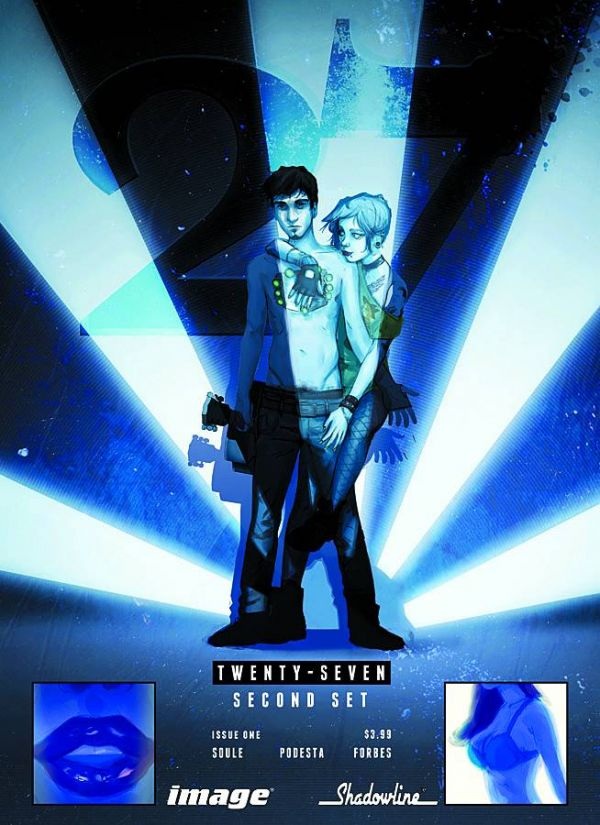 HUMPHREY LEE (HL): This first one is an easy one…for me. What do new readers need to know about the world of 27?
HUMPHREY LEE (HL): This first one is an easy one…for me. What do new readers need to know about the world of 27?CHARLES SOULE (CS): 27 is a series about rock and roll, and creativity, and spooky supernatural stuff, and how they all mix together. It’s like the best concert you’ve ever seen, but it’s a comic. More specifically, it’s the story of Will Garland, a brilliant and famous rock guitarist who finds himself dealing with the legend of the “27 Club,” the list of amazing artistic talents who died tragically at age twenty-seven. We’re talking about people like Jimi Hendrix, Jim Morrison, Kurt Cobain and most recently Amy Winehouse, to name but a few.
In the series, we set up the 27 Club as a group of people struck down by a sort of magical curse related to their extraordinary creativity and fame. Our main character turns twenty-seven, his life goes to hell, and he realizes he needs to either beat this curse and see twenty-eight, or quite literally die trying.
The story’s gone through eight issues so far - two full arcs - and I don’t think it’s inaccurate to call it a rollicking roller coaster of a good time. Anything can happen in the 27 universe, from appearances by long dead rock gods to one-hit wonder witches to deals being made with the very spirit of creativity her/itself.
HL: So I’ve known you for a few months now, particularly through the social networking type places, and there’s always a post now and again about your musical pursuits. So, naturally I have to wonder, is there a bit of 27’s lead Will Garland in you? Particularly in the aspect of how we are originally presented in the FIRST SET with a Will Garland who has had music taken away from him and will do anything to get it back?
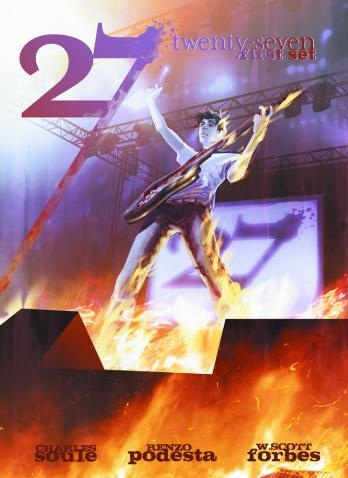 CS: Well, I see 27 as an allegory for the creative experience in general – the struggles you go through to get your work out there, the setbacks, the moments of glorious breakthrough (whether that’s coming up with the perfect line, figuring out a killer plot point, or getting a nice review) and the moments where you’re just confused and don’t know where to go next or (in your bleakest days) why you bothered in the first place.
CS: Well, I see 27 as an allegory for the creative experience in general – the struggles you go through to get your work out there, the setbacks, the moments of glorious breakthrough (whether that’s coming up with the perfect line, figuring out a killer plot point, or getting a nice review) and the moments where you’re just confused and don’t know where to go next or (in your bleakest days) why you bothered in the first place.So yeah, Garland’s definitely an extension of me in a lot of ways. I’d like to think I don’t have his rock star dickishness, but as you mention, I play guitar myself and have for years and years. So, when I write a scene where he’s finally able to play something magnificent after struggling for ages, that’s something I’ve felt many times, both in writing and music.
The speech Garland makes at the end of First Set is pretty much exactly how I feel about creativity. I don’t want to spoil it for anyone who hasn’t read it yet but he talks about what makes the creative process valuable – why it matters to make things. If I were put in that position (and I sincerely hope that will never happen), that’s more or less what I would say. One of the wonderful things about comics – or fiction in any medium – is that it lets you create these neat fictional avatars to get your worldview out there, for better or worse.
HL: How did this story come together in order to involve an aspect such as a Greek deity like Erebus and the concept of Chaos with the “real world” coincidences of famous musicians like Kurt Cobain and Jim Morrison dying at the age of 27? I’m going to assume the latter end of that was the foundation of the book - obvious given the title of the book - and you went from there, but given the uniqueness of the subject matter I guess anything goes here.
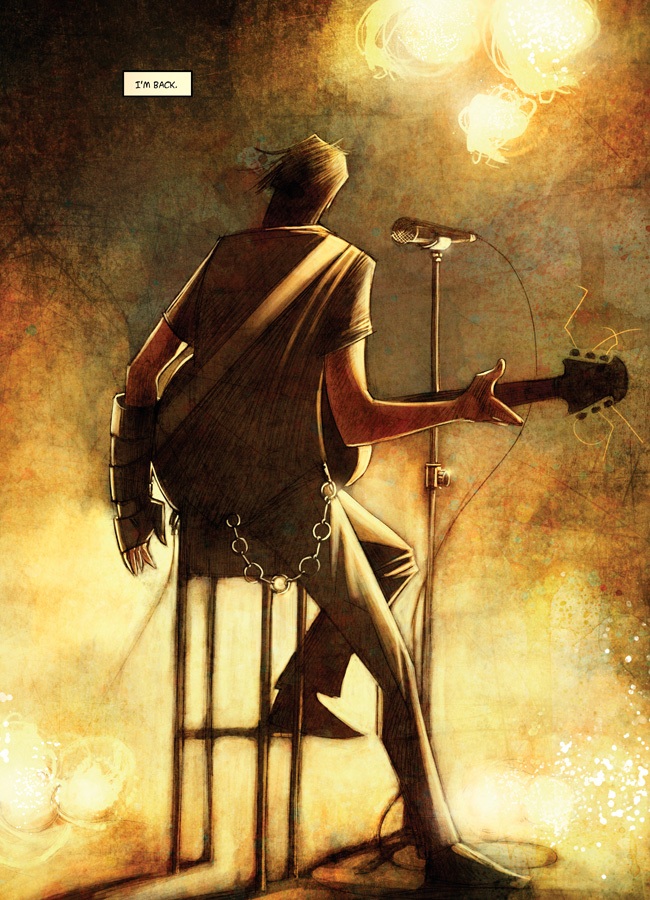 CS: Actually, my original concept didn’t include music at all. It was based around a sort of mix between DIAL H FOR HERO and STRIKEFORCE MORITURI, with a main character who could have a certain number of superpowers, each for a limited time, not knowing what he’d get when he triggered them, and would die once he used them all up. The drama would come from whether a given emergency warranted triggering a power, and then whether the power he got would actually solve the problem he was facing.
CS: Actually, my original concept didn’t include music at all. It was based around a sort of mix between DIAL H FOR HERO and STRIKEFORCE MORITURI, with a main character who could have a certain number of superpowers, each for a limited time, not knowing what he’d get when he triggered them, and would die once he used them all up. The drama would come from whether a given emergency warranted triggering a power, and then whether the power he got would actually solve the problem he was facing.Obviously, that concept made it into the book in a big way, although in a modified fashion. As part of the story, Will Garland gets a “button” in his chest that gives him three hours of genius-level creativity whenever he pushes it, in some random discipline. One time it might be jazz dance, another time topiary. Once he pushes it twenty-seven times, he’s dead.
How I went from the generic superhero thing to the much more specific (and I think cooler) version of the idea in 27 was pretty simple – I asked myself how many times he’d be able to push it before he died, thought of twenty-seven, then realized two + seven equals nine, there were Nine Muses, and I was off to the races.
My writing philosophy – or one of them, anyway – is this: “you don’t have all your good ideas at once.” Ideas need time to grow, and where you start often isn’t where you finish (and probably shouldn’t be). Connections spring from everywhere, and your subconscious needs time to find them.
At this point, I think of 27 as a kitchen sink series. It’s grounded in stories about music and fame, but part of the fun is that there are no boundaries. A story can run through a million different places and ideas, and somehow it all hangs together, I hope.
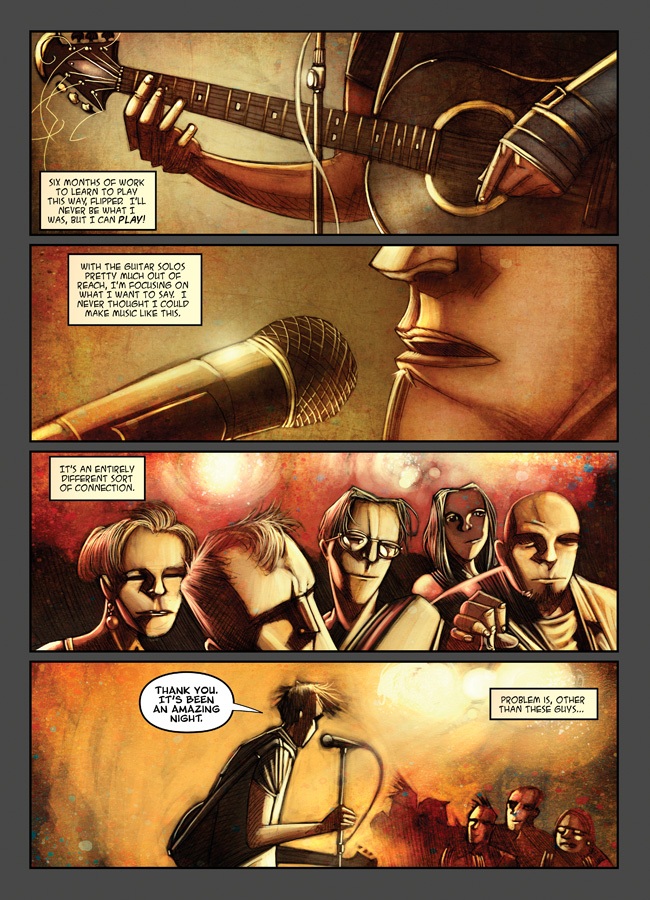 HL: Given all the subjects mentioned in that last question, do you feel this book is what you had envisioned it from the get go now that you are two volumes in, or has it already evolved itself from your original vision as it has developed?
HL: Given all the subjects mentioned in that last question, do you feel this book is what you had envisioned it from the get go now that you are two volumes in, or has it already evolved itself from your original vision as it has developed? CS: It’s definitely evolved. I have a general outline for how the series will go – it’s exploring different levels of fame and different stages of a creative career – but the specifics within that framework have taken some bizarre, awesome turns. Erebus in particular (he’s a character in the story embodying chaos and decay, essentially the God of Rot) emerging as almost a trickster god is something I didn’t anticipate, but I love. He’s sort of comic relief in SECOND SET, which makes me happy.
HL: Speaking of evolution, the SECOND SET sees Will Garland going from a man desperate to get his craft back – and succeeding to a degree he seemed pretty happy with – to a man who wants more than just his guitar back; he also makes a grab for all the limelight he used to enjoy as well. Basically he goes all “Fame Monster.” Was this intended all along or was there a bit of social commentary that steered this or somewhere in between?
CS: I wanted to make Will Garland a realistic character, even in a series that goes to some pretty outlandish places. And real people aren’t often satisfied when they get what they want. Humanity is wired for desire, and whenever we set a new baseline by achieving something we’ve been working towards, the next thing we do is decide that it’s not enough.
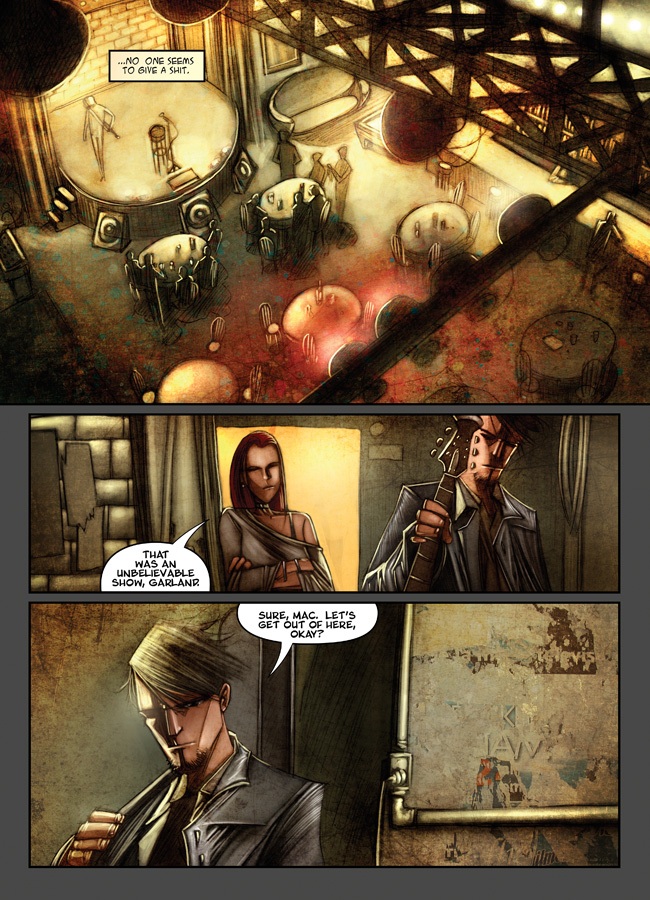 SECOND SET is concerned with a pretty age-old question: would you rather write a beautiful, perfect song and have it heard by a hundred people, or write one that’s just okay, but have it heard by a million? (You can substitute “book,” “movie,” “comic” or anything else in for “song,” obviously.) Garland struggles with the answer to this question throughout the story, and I tried to do it in a way that doesn’t completely betray the things he learns at the end of FIRST SET.
SECOND SET is concerned with a pretty age-old question: would you rather write a beautiful, perfect song and have it heard by a hundred people, or write one that’s just okay, but have it heard by a million? (You can substitute “book,” “movie,” “comic” or anything else in for “song,” obviously.) Garland struggles with the answer to this question throughout the story, and I tried to do it in a way that doesn’t completely betray the things he learns at the end of FIRST SET.But is there social commentary in SECOND SET? Absolutely. Fame is a weird thing in America these days – there’s a sense of entitlement. Fame has never seemed more achievable for the average person, and less related to actual achievement. I think it’s a weird perversion of the original concept of the American Dream – that with enough talent, hard work, luck and perseverance, anyone can make it. These days, it’s just the luck part. I’m not sitting back and judging, although there are aspects of reality TV that I think are just pathetic, but I definitely wanted to use SECOND SET as a vehicle to express some of my views on the subject.
HL: Going with the “Fame Monster” notion, this volume even introduces the “God of Fame” (and I’ll leave it at that so as not to spoil anything) to amp up the supernatural side of things. Are we going to see more and more deities getting involved in Will Garland’s life with his device?
CS: That’s the plan, although plans can change, of course. Not to spoil too much, but if you think about levels of fame, you have people who are famous for nothing (Paris Hilton, Kim Kardashian), people who are famous for being good (Adele, for example), people who have been famous for so long that they transcend whatever made them famous in the first place (Madonna, Paul McCartney), and above that you’ve got deities. I think there’s a lot that could be said about those last two levels.
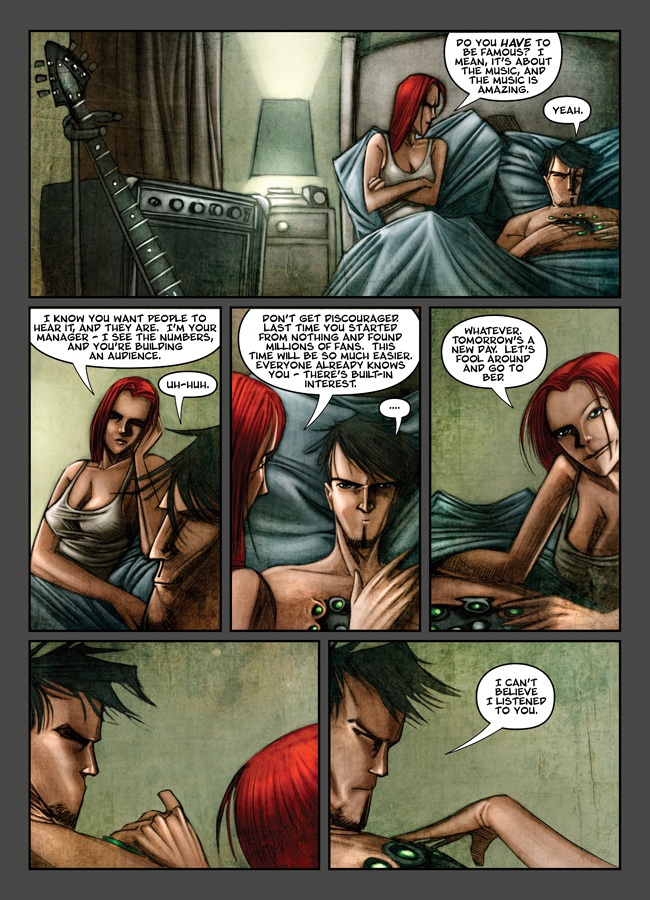 HL: Do you think maybe there should be some time to rein in the mystical side of the book and focus more on the “mortal coil” part of Will’s life? I guess I probably could have made this easier by asking you, basically, if there is a balance you’re trying to strike between these two aspects of Will’s life?
HL: Do you think maybe there should be some time to rein in the mystical side of the book and focus more on the “mortal coil” part of Will’s life? I guess I probably could have made this easier by asking you, basically, if there is a balance you’re trying to strike between these two aspects of Will’s life? CS: One of the overarching points of 27 is that when you get to really crazy levels of fame, you leave regular life behind. When was the last time Mick Jagger washed a dish, you know? Still, that doesn’t mean that people like Garland don’t have problems, but I feel like most of their issues would revolve around personal issues – it becomes very difficult to understand or trust people, because almost everyone either worships you or wants something from you. I want to explore things like that, because I bet there are some amazing character moments to be found.
HL: Since I’m already leading you into talks of balance and whatnot from here on out, I’m probably obligated to ask if you have a master plan for this book as far as concepts left to be introduced, series length, and the like. Or are all these things relative to how you feel as you are actually writing the book and also continuing to evolve?
CS: I do have a master plan. I don’t think 27 could, or should, go forever. We’re currently trying to figure out how, where, when (and even if) to finish it up. The folks at Shadowline are great, but it’s a weird world right now for indie comics, and the business side of every book has to be taken into account. On the other hand, the way people are finding and reading content seems to be evolving minute to minute, and that’s opening up tons of new ways to get stories to readers – and even make a little money doing it.
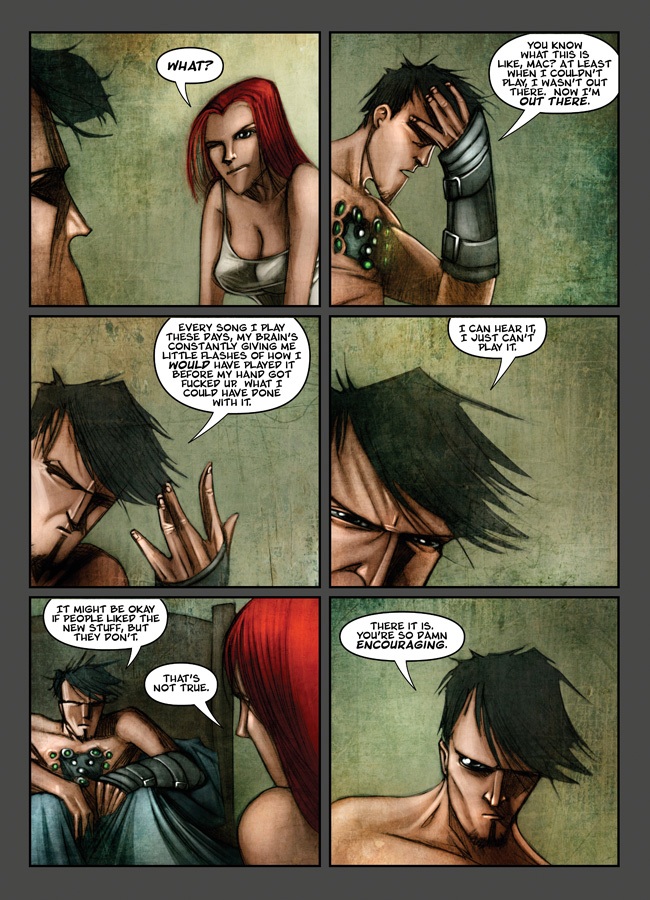 For example, 27 is currently being serialized as a webcomic on the awesome Keenspot site. We started right at the beginning in March, and we’re putting out a new page every weekday, totally free. We’ll run it all the way through SECOND SET. It’ll take a while to get there, but the audience so far has been magnificent – we’re talking 6-figure monthly page views, which is extraordinary. First Set was selected as a 2012 Great Graphic Novel for Teens by YALSA (Young Adult Library Services Association), which was incredibly flattering, and could help get us in front of impressionable young minds.
For example, 27 is currently being serialized as a webcomic on the awesome Keenspot site. We started right at the beginning in March, and we’re putting out a new page every weekday, totally free. We’ll run it all the way through SECOND SET. It’ll take a while to get there, but the audience so far has been magnificent – we’re talking 6-figure monthly page views, which is extraordinary. First Set was selected as a 2012 Great Graphic Novel for Teens by YALSA (Young Adult Library Services Association), which was incredibly flattering, and could help get us in front of impressionable young minds.And of course, the beautiful SECOND SET trade hits on May 23, 2012 ( you can get that, and the trade for FIRST SET, here, as well as digitally here.
I present those links not so much to shill, although shilling is a part of indie comics that’s never going away, but to give you a way to get THIRD SET happening sooner rather than later. I’ll do it eventually, one way or another, but having a proven, supportive audience is the best way to get more of any comic you love, not just 27. No matter how well you think some indie title is doing, it needs your love and support. Believe me.
HL: Shill, baby, shill. That’s what we’re here for. While on the subject of the future, since you already oh so slyly moved us your future content, do you maybe have a commentary on this boom Image has been seeing during the tenure 27 has had there and what it means for creators such as you?
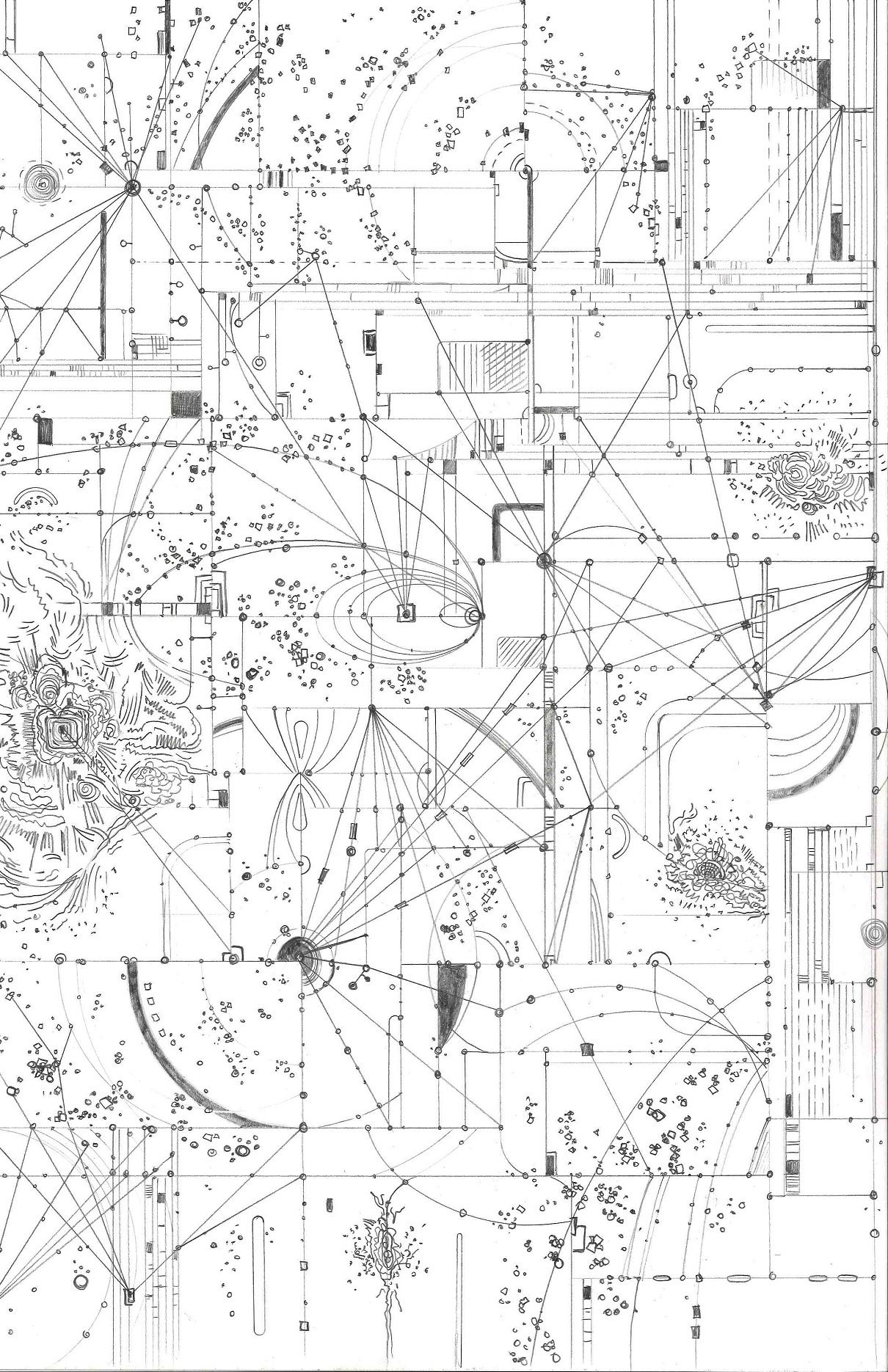 CS: I think the Image boom is spectacular for anyone trying to do creator-owned stuff. It’s underscored the amazing diversity of story available outside superhero adventures, which is a great thing. Retailers and audiences are more willing to take a chance on something new, and that’s phenomenal.
CS: I think the Image boom is spectacular for anyone trying to do creator-owned stuff. It’s underscored the amazing diversity of story available outside superhero adventures, which is a great thing. Retailers and audiences are more willing to take a chance on something new, and that’s phenomenal.As far as my own upcoming projects, I have a beautiful book coming from Archaia this fall called STRANGE ATTRACTORS. It’s essentially about an old mathematician in New York City who figures out how to create a sort of complexity map of all of the city’s various systems and how they interrelate – power, traffic, economy, people, politics, etc. With that map, he can make the city into a kind of engine, and from there the story’s about what happens when he turns it on. The art is by a very talented Staten Island native named Greg Scott, with colors by Art Lyon. A Brooklyn-based fine artist named Robert Saywitz is designing the maps themselves, and they are beautiful. This is an early version of one, and the finals are incredible (Editor’s note: on the left). It’s really my love letter to New York, a city I’ve lived in for more than fifteen years.
HL: That probably more than covers everything we should cover about 27 for now (considering this is already pimpage for a volume about to hit shelves) but is there anything else you have to share? Is there anywhere we should be going to see you display your musical talents as well? This space is made for pimping.
 CS: Music? Well, comics have been dipping into my music time for a while now, but I did record nine covers of one-hit wonders (OHWs are a big theme in SECOND SET) last fall in advance of the release of SECOND SET #1. You can hear them all here, if you’re so inclined. You can follow me on Twitter here. , and I keep a blog here at that’s updated not infrequently.
CS: Music? Well, comics have been dipping into my music time for a while now, but I did record nine covers of one-hit wonders (OHWs are a big theme in SECOND SET) last fall in advance of the release of SECOND SET #1. You can hear them all here, if you’re so inclined. You can follow me on Twitter here. , and I keep a blog here at that’s updated not infrequently.Beyond that, there’s plenty in the pipeline. I’ve been working on something big for another publisher – folks I haven’t worked with before but I’m very excited about – which I expect to announce pretty soon. If everything goes well, I’ll have stuff out for a while yet. As long as people keep reading, I’ll keep writing.
So, there you have it folks. Musician, writer, hater of Kim Kardashian and quite the Renaissance Man be he, Charles Soule. If you seem interested in the world of 27 after all that, I point you to some more coverage we here at AICN have done on the book here, here, and here. And I would of course remind you that the collected edition of 27: SECOND SET will be on shelves this Wednesday, May 23rd. Cheers…
Humphrey Lee has been an avid comic book reader going on fifteen years now and a contributor to Ain't It Cool comics for quite a few as well. In fact, reading comics is about all he does in his free time and where all the money from his day job wages goes to - funding his comic book habit so he can talk about them to you, our loyal readers (lucky you). He's a bit of a social networking whore, so you can find him all over the Interwebs on sites like Twitter, The MySpaces, Facebookand a blog where he also mostly talks about comics with his free time because he hasn't the slightest semblance of a life. Sad but true, and he gladly encourages you to add, read, and comment as you will.
Proofs, co-edits & common sense provided by Sleazy G
